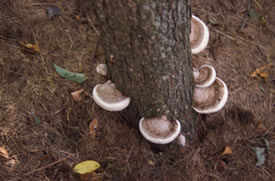
Wood Rots and Decays
Many genus and species involved
23 pictures total.



Wood rot shelf fungi on rotting tree.
|
| Severity: |
4 out of 5 |
| Frequency: |
4 out of 5 |
| Symptoms: |
One group of wood rots are called shelf fungi since the reproductive structure sticks out like a shelf on a wall. The shelf fungi are divided into two groups. One group's fruiting structure is soft and can usually be quickly replaced if damaged or destroyed. The other group's reproductive structure is hard. They are conks and are sometimes called artistic fungi since writings/pictures can be drawn on the lower surface and these drawings last for years. The conks grow slowly and produce growth rings just like most trees. Some decay organisms make mushrooms/toadstools while some make puffballs. Some decay fungi make a "fuzzy-like" structure on the out side of the tree/wood. They may be in a variety of colors. Wood rots break down only dead woody material. Therefore, a tree may be rotting internally and still be able to maintain a full canopy of foliage since phloem, cambium, and sapwood are still active. Some trees show no external symptoms. Other trees may have openings and hollows in a branch or trunk which is another symptom of wood rot. |
| Cycle: |
Varies with the pathogen causing the decay. |
| Management: |
Rotting trees can be unsafe, especially when they overhang homes, other structures, as well as play areas. One must decide the risk level one is willing to take with his or her life and the lives of their loved ones. If the tree will not cause damage or loss of life when it falls, leave the tree standing. If damage or loss of life is a possibility, consider removing the tree as soon as possible. |
| Associated trees: |
- Hedge Maple
- Paperbark Maple
- Miyabe Maple
- Norway Maple
- Red Maple
- Silver Maple
- Sugar Maple
- Yellow Buckeye
- Ohio Buckeye
- Common Horsechestnut
- Red Buckeye
- Red Horsechestnut
- European Alder
- Pawpaw
- Yellow Birch
- Sweet Birch, Cherry Birch
- River Birch
- Paper Birch
- European White Birch
- Asian White Birch
- Gray Birch
- European Hornbeam
- American Hornbeam, Musclewood, Ironwood
- Shellbark Hickory
- Shagbark Hickory
- Chinese Chestnut
- Southern Catalpa
- Northern Catalpa
- Common Hackberry
- Katsuratree
- Eastern Redbud
- White Fringetree
- American Yellowwood
- Pagoda Dogwood
- Flowering Dogwood
- Kousa Dogwood
- Corneliancherry Dogwood
- Turkish Filbert
- Cockspur Hawthorn
- Downy Hawthorn
- Washington Hawthorn
- Green Hawthorn
- Common Persimmon
- American Beech
- European Beech
- White Ash
- European Ash
- Green Ash
- Blue Ash
- Thornless Common Honeylocust
- Kentucky Coffeetree
- Carolina Silverbell
- Black Walnut
- European or Common Larch
- Eastern Larch, Tamarack
- Sweet Gum
- Tuliptree
- Osage Orange, Hedgeapple
- Cucumbertree Magnolia
- Star Magnolia
- Loebner Magnolia
- Saucer Magnolia
- Crabapple
- Common Mulberry
- Black Gum, Sour Gum, Black Tupelo
- Hophornbeam, Ironwood
- Amur Corktree
- Norway Spruce
- White Spruce
- Serbian Spruce
- Colorado Spruce
- Lacebark Pine
- Swiss Stone Pine
- Limber Pine
- Austrian Pine
- Red Pine
- Eastern White Pine
- Scots Pine
- Sycamore
- London Planetree
- White Poplar, Silver Poplar
- Eastern Cottonwood
- Cherry Plum
- Amur Chokecherry
- European Birdcherry
- Sargent Cherry
- Black Cherry, Wild Cherry
- Weeping Higan Cherry
- Callery Pear
- White Oak
- Swamp White Oak
- Northern Pin Oak
- Shingle Oak
- Bur Oak
- Pin Oak
- Red Oak
- Black Oak
- Black Locust
- White Willow
- Japanese Pagodatree, Chinese Scholartree
- Korean Mountainash
- European Mountainash
- Japanese Tree Lilac
- American Linden, Basswood
- Littleleaf Linden
- Silver Linden
- Canada Hemlock
- American Elm
- Chinese Elm, Lacebark Elm
- Japanese Zelkova
|

